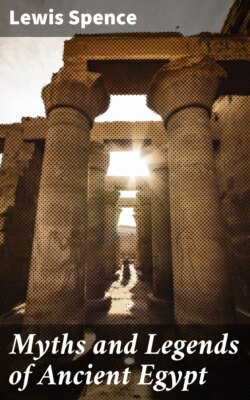Читать книгу Myths and Legends of Ancient Egypt - Lewis Spence - Страница 43
На сайте Литреса книга снята с продажи.
The Holy Place
ОглавлениеThis, the Holy Place, was the chief room of the temple. Here stood the naos, a box rectangular in shape and open in front, often with a latticework door. This served as the receptacle of the divine symbols or in some cases as the cage of the sacred animal. On either side of the sanctuary were dark chambers, used as the store-rooms for the sacred vestments, the processional standards and sacred barque, the temple furniture, and so on. It is to be noted that as the progression was from the blazing light of the first great court to the complete darkness of the Holy of Holies, so the roofs grew less lofty. The inside walls and columns were decorated with reliefs in brilliant colours depicting the rites and worship connected with the presiding deity in ceremonial order.
Surrounding the temple was the temenos, enveloped by a wall in which were situated other and smaller temples, with groves of sacred trees and birds, lakes on which the sacred barque floated, the dwellings of the priests, and sometimes palaces amid the gardens. Outside again were sacred ways that led in different directions, some branching from temple to temple, through cities, villages, and fields, while at the side steps sloped down to the Nile, where boats were anchored. Along these ways went the sacred processions, bearing the images of the gods; by them came the monarch in royal state to make offerings to the gods; and here the dead were carried to their tombs across the Nile.
Greece has frequently been alluded to as the 'Land of Temples.' The appellation might with greater justice be applied to Egypt, where fanes of Cyclopean magnitude rose in every nome ere yet Hellas could boast knowledge of the mason's art. Still they stand, those giant shrines, well-nigh as perfect as when fresh from the chisels of the old hierophants who shaped and designed them. And so long as a fostering love of the past dwells in the heart of man so long shall they remain.
[1] See Seligmann, Journal of the Royal Anthropological Institute, vol. xliii.
[2] Sebek.
Osiris—Photo W.A. Mansell & Co.
